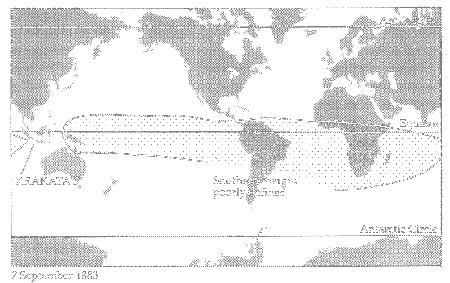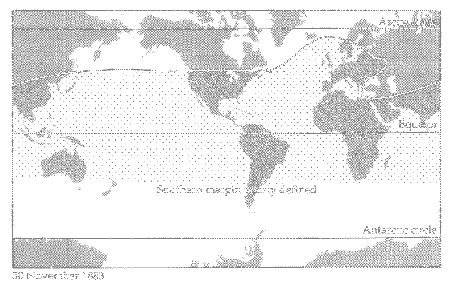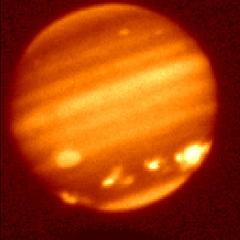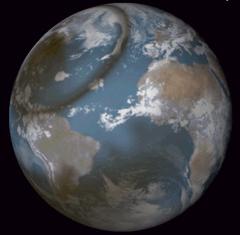
Introduction
Global climate catastrophes are events which, in a short period of time, alter Earth's climate system. The change is sudden and discontinuous from normal climate trends. The catastrophe permanently changes the entire climate system or alters climatic cycles appreciably. Few things fit these criteria; most processes, such as cooling and glaciation, take place gradually, not catastrophically, over an extended period of time. The events that qualify as GCCs include events like nearby supernovae and the Earth's passing through a nebula or similar cosmic structure. These events are too unpredictable and unknown to be discussed realistically, but there are others which are much more likely and much closer to home. A huge volcanic eruption, celestial impact, and nuclear war are all GCCs which have a very real possibility of occurring.
Volcanism
 |
 |
Summer 1816 in the Northern Hemisphere brought abnormally low daily temperatures, especially daily minima. Higher than average snowfall occurred in northern New England and Canada and heavy rains fell in Western Europe. The 1816 summer average temperatures on the east coast of North America, between 1.5°C and 2.5°C below average, were the coldest on record (4). Also well below the seasonal norms were Edinburgh (-1.5°C), Budapest (-1.6°C), Rome (-1.4°C) and Hohenpeissenburg (-2.6°C) (6). There were widespread crop failures, delayed harvests, and famine. Byron was inspired by the event to write Darkness:
Another volcano that caused climate change, albeit temporary, was Krakatau. Krakatau's pinnacle of activity occurred on 26 and 27 August, 1883. The volcano spewed out about 20 cubic km of matter in a column which reached 40 km height (4). The area covered by pumice and fine ash after the eruption was about 827,000 km2 (6). This is dwarfed, however, by the dust and ash that was thrust into the stratosphere by the volcano. This material was carried westward at about 33 meters per second, eventually circling the earth several times, spreading in a north-south direction as it was carried by the wind. After the second circuit, it was observed that it took three to four days to pass over equatorial locations. This implies that the dust cloud had spread to a very elliptical cloud (Figure 1.2), over 10,000 km on its major axis (7). There is a general consensus that the 1883 Krakatau eruption had a cooling effect in the Northern Hemisphere of about 0.25°C for a period of one to two years. In polar latitudes (60°-90° N), the cooling averaged a full 1°C (4).
The temporary climate effects brought on by the huge amounts of dust and ash emitted by these two volcanoes points to the possibility of a greater change, brought on by a greater volcano. A larger volcano could emit enough tephra to decrease global average temperatures much more. This extreme cooling (perhaps even 5°C), combined with associated changes in biota, could have a profound effect on the global climate.
Celestial Impact
"The era of the dinosaurs came to an end 65 million years ago, when the Earth was struck by an object only about 10 km across, but which imparted a blow so severe that it disrupted the environment and hurled so much material into the air that when it settled out it formed a layer of clay still detectable in sedimentary rocks around the world. It was the equivalent of a rock the size of Mount Everest, travelling ten times faster than the fastest bullet, producing an impact so severe that the entire earth shifted in its orbit by a few dozen metres and the length of the year changed by a few hundredths of a second." (5)
This is the effect that a comet or asteroid has upon impact. A bolide merely 10 km in diameter, but having immense kinetic energy, plunging through the atmosphere to impact the surface with such incredible force that rock layers around the planet show evidence of the impact. Earth is not the only planet in danger from a celestial impact: in 1994, Comet Shoemaker-Levy impacted Jupiter in the same fashion.
 |
 |
The cometary impact 65 million years ago in the Yucatan left a crater of approximately 180 km diameter. The bolide itself massed approximately 2 x 1018 grams, and depending on its density, had a diameter of anywhere from 16 km (at 1.0g/mm density) to 33 km (at 0.1g/mm density) (3). When it impacted Earth, it spread immense quantities of dust-sized ejecta into the atmosphere. Fires from the heat of impact ravaged the earth, burning thousands of square kilometers of forest and adding millions of tons of soot to the already-polluted atmosphere. This dust and soot caused complete light extinction worldwide for a period of several months. The lack of sunlight (and therefore lack of heat) caused extreme cold temperatures for a period of several years (1) -- an impact winter. This climate change caused the extinction of many species around the planet, including the dinosaurs, and marked the end of the Cretaceous era.
Even had the impact occurred in the ocean (there is a 71% chance that any given impact will land in water), this ejecta dust would still form. A bolide over 16 km diameter is falling into an ocean which is generally about 5 km deep!
Nuclear War
The immediate effects of a full-scale nuclear exchange are obvious. These are the dangers with which we grew up and were taught about in schools. What we generally were not taught is the longer-term effects, the most prominent of which is the climatic effect.
One of the primary climatic effects of a nuclear war is the destruction of the stratospheric ozone layer. Nitrogen oxides created by the energy of nuclear warheads react with stratospheric ozone such that the nitrogen oxide acts as a catalyst, causing two ozone molecules to break down and form three oxygen molecules. The ozone content of the stratosphere would reach a minimum after a period of a few months, depending on the magnitude of the explosive yield, the height of the detonations and many other factors (9).
From an atmospheric point of view, the most damaging effect of nuclear war would be from the fires. The fires that start in a nuclear war can cause complete combustion of fuel over a large area. Studies suggest that there would be immediate ignition of from 250 to 375 km2 for each megaton yield (9). These fires will then certainly spread. In Hiroshima, the burned area reached 1200 km2 per megaton. All of this burned material releases its components (55 percent tar, 25 percent soot, 20 percent ash) (8) to the atmosphere. The soot, smoke and other particulate matter created by the fires will act just as the volcanic soot and the dirt from cometary impact did : it will block sunlight from reaching the earth, causing global cooling for a period of months due to lack of heat and light. The potential maximum cooling during this nuclear winter is unknown, but would undoubtedly be devastating to plants and animals alike. Becher (2) states that the drop could be as much as 30°C. Another scenario suggested that if Northern Hemisphere cities were targeted in summertime (a worst-case), solar energy reaching the mid-latitudes could be decreased by 80 percent or more, leading to a decreased average mid-latitude temperature of 5°C to 20°C (9). As the smoke spreads southward, the temperature changes become more moderate but occur over a larger area. Within a few weeks, the temperature of the tropics and subtropics drops 5°C to 10°C on average.
The models run also show that drastic changes in the precipitation pattern occur. Precipitation in the middle and low latitudes of the Northern Hemisphere dropped by a factor of 5 during the first weeks (9) due to the warming of the atmosphere and cooling of the surface. In addition, the summer monsoon patterns would be repressed under conditions of even small amounts of smoke (9).
Conclusion
Any of these three catastrophes – volcanoes, celestial impact, or nuclear war – can cause severe and semipermanent or permanent climate change through dust loading of the atmosphere. The change in climate caused by any of these three phenomena would certainly be to the detriment of all those affected by the change, and most certainly would be bad for humankind.
The main comfort to be taken is that the chance of any of these occurring is low. No volcano in history has ever been powerful enough to cause more than a temporary climate change. The chance of a bolide impact is extremely low; it has been called a once in 100 million year event (3). Since the breakup of the USSR, the chances of a full-scale nuclear conflict have been steadily decreasing. A strictly limited nuclear conflict would not be likely to cause permanent climatic change.
References
1. Albritton, C. C., Catastrophic Episodes in Earth History (New York: Chapman and Hall, 1989).
2. Becher, S., Greenwood, B., Cosmic Catastrophes (Salt Lake City: Hansen Planetarium, 1993).
3. Carlisle, D. B., Dinosaurs, Diamonds, and Things from Outer Space (Stanford: Stanford University, 1995).
4. Francis, P., Volcanoes: A Planetary Perspective (New York: Oxford University Press, 1993).
5. Gribbin, J., Gribbin, M., Fire on Earth: Doomsday, Dinosaurs, and Humankind (New York: St. Martin’s, 1996).
6. Kondratyev, K. Ya., Volcanoes and Climate (World Meterological Organization - World Climate Research Programme, 1983.)
7. Lamb, H. H., Volcanic Loading: The Dust Veil Index (U. S. Department of Energy - Carbon Dioxide Information Center, 1985).
8. Peterson, J., ed., Nuclear War: The Aftermath (Oxford: Pergamon, 1983).
9. United Nations, Study on the Climatic and Other Global Effects of Nuclear War (New York: United Nations, 1989).
Selected Bibliography
Albritton, C. C., Catastrophic Episodes in Earth History (New York: Chapman and Hall, 1989).
Barry, R. G., Chorley, R. J., Atmosphere, Weather, and Climate (Routledge: New York, 1992).
Becher, S., Greenwood, B., Cosmic Catastrophes (Salt Lake City: Hansen Planetarium, 1993).
Berggren, W. A., Van Couvering, J. A., Catastrophes and Earth History: The New Uniformitarianism (Princeton: Princeton University Press, 1984).
Blong, R. J., Volcanic Hazards: A Sourcebook on the Effects of Eruptions (Sydney: Academic, 1984).
Bourriau, J., ed., Understanding Catastrophe (New York: Cambridge University Press, 1995).
Budyko, M.I., Golitsyn, G.S., Izrael, Y.A., Global Climatic Catastrophes (New York: Springer-Verlag, 1988).
Carlisle, D. B., Dinosaurs, Diamonds, and Things from Outer Space (Stanford: Stanford University, 1995).
Clube, V., Napier, B., The Cosmic Winter (Oxford: Basil Blackwell, 1990).
Fisher, D. E., Fire & Ice: The Greenhouse Effect, Ozone Depletion, and Nuclear Winter (New York: Harper and Row, 1990).
Francis, P., Volcanoes: A Planetary Perspective (New York: Oxford University Press, 1993).
Gribbin, J., Gribbin, M., Fire on Earth: Doomsday, Dinosaurs, and Humankind (New York: St. Martin’s, 1996).
Kondratyev, K. Ya., Volcanoes and Climate (World Meterological Organization - World Climate Research Programme, 1983.)
Lamb, H. H., Volcanic Loading: The Dust Veil Index (U. S. Department of Energy - Carbon Dioxide Information Center, 1985).
Officer, C., Page, J., The Great Dinosaur Extinction Controversy (Reading, Massachusetts: Helix, 1996).
Peterson, J., ed., Nuclear War: The Aftermath (Oxford: Pergamon, 1983).
United Nations, Study on the Climatic and Other Global Effects of Nuclear War (New York: United Nations, 1989).